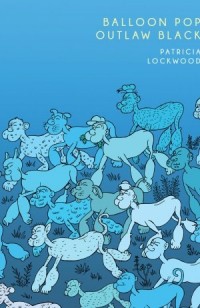25 Points: Balloon Pop Outlaw Black
 Balloon Pop Outlaw Black
Balloon Pop Outlaw Black
by Patricia Lockwood
Octopus Books, 2012
104 pages / $12.00 buy from Octopus Books or SPD
1. “Popeye.” The protrude of oldest skin, the swell of the part that sees.
2. “TITLE FONT SET IN CHAMPAGNE & LIMOUSINES.”
3. “Regarding ink, why black? Black because something was extinguished there?”
(When We Move Away From Here, You’ll See A Clean Square of Paper Where His Picture Hung)
Lines. Black Lines, (Saying those words out loud to myself makes me think of Lockwood’s Octopus partner, Ben Mirov, and his Black Glass Solioquy), are so important to Balloon Pop Outlaw Black (to every text) and to the powerful, self-conscious nature of its “drawn” characters. They are how the cartoons come to appear into their paperflatbookflat, but moving “Popeye” worlds. They are what all of our poems are b(l)oated with and lifted with and broken up by.
4. I forgot my razor in Minnesota, so there are small black lines coming out of my armpits and legs right now. I hesitated the first time I bought a bra that was black. Do you remember when that meant [inside of a Ten Things I Hate About You cultural map] that you were aching to have sex with whatever boymachine? I sat behind a hot girl named Sara in a history class and saw black lines coming out of and through the material of her white Calvin Klein t-shirt. I believed that it was those lines that made boymachines popeye and pupeye across the cover of yearbooks like “blueprints of bulls” (Killed With An Apple Corer, She Asks What Does That Make Me).
5. Now I believe all of your underwear is made of glowing and changing moodring material.
6. It is black lines, night letters, dark lines, definite lines that create and strong arm identity here in this text, that attract all words and beings of this dynamic hair forest together into their lonely, swallowing on swallowing world.
“The dimension is a coat; it is flowered on the green ground. The cartoon wouldn’t wear it if
his mother didn’t force him” (The Cartoon’s Mother Builds A House in Hammerspace).
7. In BPOB, however, lines become, are pushed brilliantly to be, what also gulps identity up, what bruises it around. It’s beautiful burst. It’s hammerwriting.
Elisabeth Workman, mentions a quote by Lisa Robertson inside her Cuntos Manifesto that feels imperative every time I re-read Lockwood’s poems and every day I make toast, “Identity is very ungenerous and completely non-erotic.” The characters here, the speakers here, want to allow themselves to fall apart while engulfed under the speechlove of another dark line or person or word as it invades and saturates and distorts them into bigger better. It think it is the best picture of a galaxy.
8. “And it’s hard to tell where the house ends and her insides
begin, there is so much inside around her”
(The Cartoon’s Mother Builds A House in Hammerspace).
9. “How can she always arrive at him?”
(The Cartoon’s Mother Builds A House in Hammerspace)
10. Lockwood’s characters: a whale, a boy, a mother, a father, a she, “Popeye”, a he, crawl at us and at each other with cartoon mouths and cartoon chests. They aren’t comic books. Their muscles are not hyper-masculine or hyper-realistic. Their muscles look like little bumps on the page. Cartoons brush against almost being pathetic constantly, just like we/I do. It’s what is funny. And it is what makes so much room for interesting there and in BPOB. READ MORE >
January 31st, 2013 / 12:08 pm
